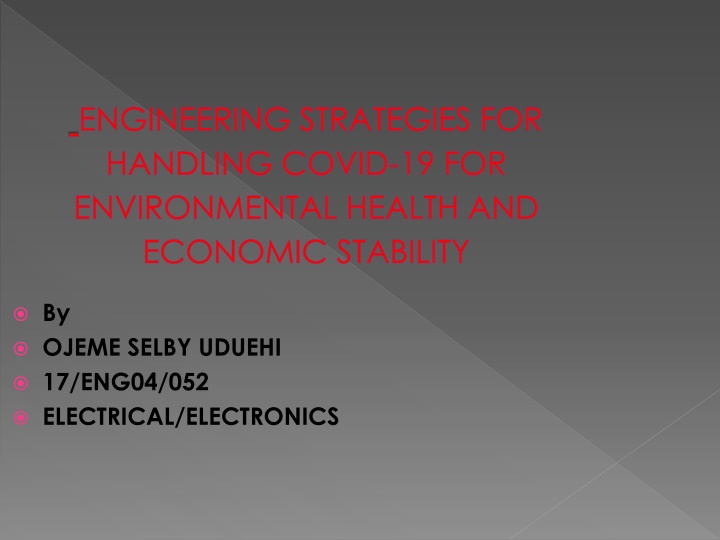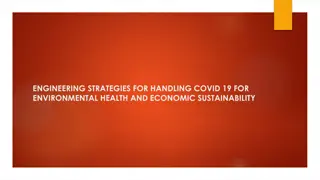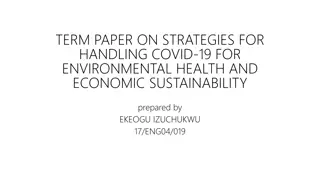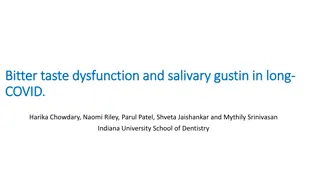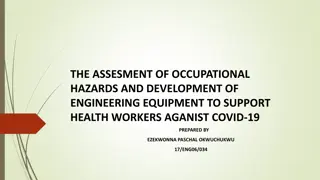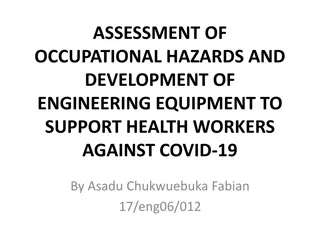Strategies for Handling COVID-19: Engineering Solutions for Health and Stability
This presentation by Ojeme Selby Uduehi discusses engineering strategies to combat the spread of COVID-19, focusing on open-source ventilators and the use of online narratives to ensure continuity in education and work environments. Understanding the importance of sustainable development, the presentation emphasizes the role of technology in addressing challenges posed by the pandemic.
Download Presentation

Please find below an Image/Link to download the presentation.
The content on the website is provided AS IS for your information and personal use only. It may not be sold, licensed, or shared on other websites without obtaining consent from the author.If you encounter any issues during the download, it is possible that the publisher has removed the file from their server.
You are allowed to download the files provided on this website for personal or commercial use, subject to the condition that they are used lawfully. All files are the property of their respective owners.
The content on the website is provided AS IS for your information and personal use only. It may not be sold, licensed, or shared on other websites without obtaining consent from the author.
E N D
Presentation Transcript
ENGINEERING STRATEGIES FOR HANDLING COVID-19 FOR ENVIRONMENTAL HEALTH AND ECONOMIC STABILITY By OJEME SELBY UDUEHI 17/ENG04/052 ELECTRICAL/ELECTRONICS
The presentation aims to explain the engineering strategies used in curbing the spread of COVID-19
OPEN SOURCE VENTILATORS : DEFINITION An open-source ventilator is a disaster- situation ventilator made using a freely-licensed (open source) design, and ideally, freely-available components and parts. Designs, components, and parts may be anywhere from completely reverse engineering or completely new creations, components may be adaptations of various inexpensive existing products, and special hard-to-find and/or expensive parts may be 3d printed instead of purchased.
SCHEMATICS OF AN OPEN SOURCE VENTILLATOR
THE USE OF AN OPEN SOURCE VENTILLATOR
OPEN SOURCE VENTILLATORS AN IT S IMPORTANCE IN SUSTAINABLE DEVELOPMENT They help in the outgoing pandemic(covid-19)by helping improve the breathing rate of the patient With the deployment of more ventillators we will be able to attend to every one who has been affected by the virus.
THE USE OF ONLINE NARRATIVES As the COVID-19 coronavirus continues to spread, schools and offices around the globe are shifting to online narratives in an effort to slow the spread of the disease whille also being productive at the same time.Members of ISTE s professional learning networks have been hard at work identifying key practices for successful online learning. Here are some of the best ideas from educators from around the world, many of whom have already been teaching during coronavirus closures.
WAYS OF ENSURING/ENABLING THE USE OF ONLINE NARRATIVES (1)Ensuring digital equity-Digital equity ensures individuals and communities have the information technology capacity needed for full participitation in our societ,democracy and economy (2) Practice-Like the old saying goes ,practice makes perfect ,The more you practice using the online narrative the more you get better at it (3)Devotion and Dedication The more you are dedicated and devoted to using the online narrative ,The more you get better and see your self striving at it. (4)Take a break-Don t use your full day trying to learn it, Remember the saying that slow and steady wins the race always have break intervals.
OTHER WAYS OF ENSURING THE USE OF ONLINE NARRATIVES Making time to exercise. Keep to a regular sleep schedule. Limit distractions when possible (turn off social media notifications, for example). Set daily and weekly goals. Make time to socialize, even if it s virtually.
TECHNOLOGICAL MEASURES The World Health Organization has declared the coronavirus a global health emergency in recognition that the disease risk no longer is confined to China. United Nations member countries may decide to close their borders, cancel flights, implement special screenings at airports, or take other steps in response to the notice. U.S. health officials announced they would fast-track work on a coronavirus vaccine, with the goal to have an early-stage trial within three months. That timeline is considered optimistic, and even if the work proceeds apace, a phase 1 trial is still a long way from a vaccine ready for mass deployment, the National Institute of Allergy and Infectious Diseases, an agency within the Department of Health and Human Services, has emphasized. It could take a year or even longer before any vaccine is released for widespread use. That is likely of little comfort to those in the Chinese city of Wuhan, which is ground zero for the coronavirus outbreak and essentially has been quarantined. As of this week, the virus has killed 106 people in mainland China, and it has infected nearly 4,700 people worldwide, including in the United States.
METHODS OF CURBING IT Detection Technology Aside from quarantines, efforts to halt the spread of disease include screenings. It has gotten far easier to determine if someone is contagious and carrying an illness through various methods of detection, which can be as simple as taking temperatures and observing individuals for symptoms."A helpful way that technology can and is being used to stop the spread of illness is the use of public health surveillance data," noted Snell. The effectiveness can be hit or miss, however, largely depending on the virus. "In the case of the coronavirus, scientists say that the viral shedding period -- period when you are contagious -- can occur up to a week before you start to show symptoms," Snell explained.
Predictive Technology Technology isn't just used just to determine if someone is ill, however. Advances in artificial intelligence and machine learning now are being used to predict where an outbreak might occur -- or even more importantly, where it might spread. One such effort is an early-warning system that utilizes artificial intelligence and machine learning, as well as natural language processing, to track more than 100 infectious diseases, developed by the Canadian firm BlueDot. The program is designed to read from more than 100,000 articles in 65 languages, and the data then is compiled to determine the potential for the spreading of diseases. It was used earlier this month to track the coronavirus and then predict where it might spread.
Crowdsourcing Disease Tracking A number of crowdsourcing methods could be effective in tracking the spread of disease. "People are also using cellphone data to track population movement and how they interact," noted Snell. "This helps understand or predict where disease may spread so that scientists and healthcare providers can take a proactive approach," she added. Social media is another promising avenue. "Algorithms have been set up to detect certain buzzwords like 'flu' or 'food poisoning' to detect and track possible large-scale outbreaks," noted Snell.
Connected World The ease with which so many people can jet set around the world for business meetings, conferences, trade shows, vacation and other occasions also has contributed to the spread of contagious diseases. Perhaps some of those occasions for travel eventually could transition to virtual reality or augmented reality experiences -- both to save money for the participants, and to keep big gatherings -- such as the annual CES or the Davos political gathering -- from becoming ground zero for a pandemic.
CONCLUSION IN CONCLUSION,These are the various engineering strategies/methods that can be used in curbing the spread of covid- 19 while still ensuring economic growth and stability
